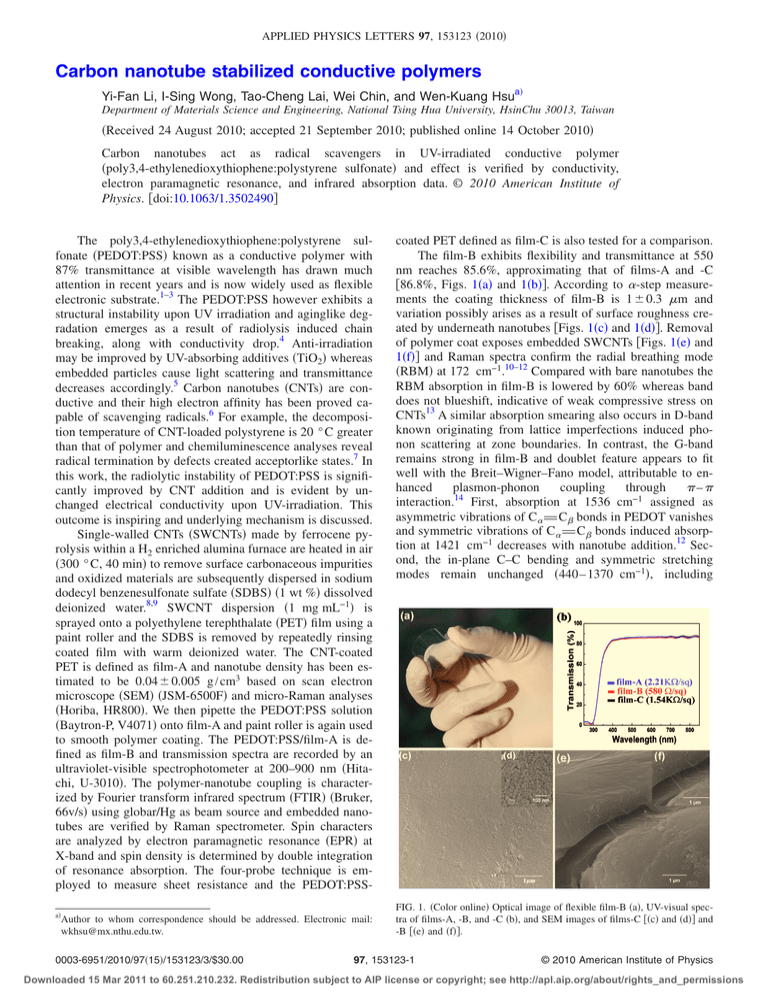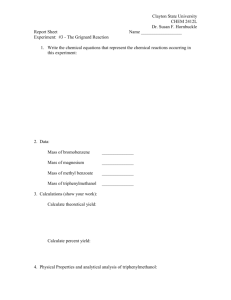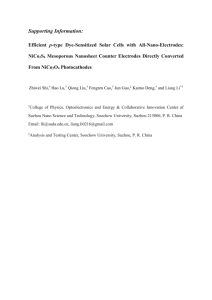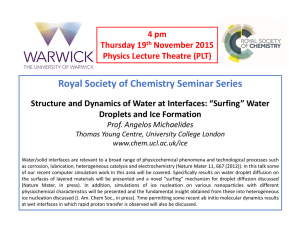APPLIED PHYSICS LETTERS(Appl. Phys. Lett)
advertisement

APPLIED PHYSICS LETTERS 97, 153123 共2010兲 Carbon nanotube stabilized conductive polymers Yi-Fan Li, I-Sing Wong, Tao-Cheng Lai, Wei Chin, and Wen-Kuang Hsua兲 Department of Materials Science and Engineering, National Tsing Hua University, HsinChu 30013, Taiwan 共Received 24 August 2010; accepted 21 September 2010; published online 14 October 2010兲 Carbon nanotubes act as radical scavengers in UV-irradiated conductive polymer 共poly3,4-ethylenedioxythiophene:polystyrene sulfonate兲 and effect is verified by conductivity, electron paramagnetic resonance, and infrared absorption data. © 2010 American Institute of Physics. 关doi:10.1063/1.3502490兴 The poly3,4-ethylenedioxythiophene:polystyrene sulfonate 共PEDOT:PSS兲 known as a conductive polymer with 87% transmittance at visible wavelength has drawn much attention in recent years and is now widely used as flexible electronic substrate.1–3 The PEDOT:PSS however exhibits a structural instability upon UV irradiation and aginglike degradation emerges as a result of radiolysis induced chain breaking, along with conductivity drop.4 Anti-irradiation may be improved by UV-absorbing additives 共TiO2兲 whereas embedded particles cause light scattering and transmittance decreases accordingly.5 Carbon nanotubes 共CNTs兲 are conductive and their high electron affinity has been proved capable of scavenging radicals.6 For example, the decomposition temperature of CNT-loaded polystyrene is 20 ° C greater than that of polymer and chemiluminescence analyses reveal radical termination by defects created acceptorlike states.7 In this work, the radiolytic instability of PEDOT:PSS is significantly improved by CNT addition and is evident by unchanged electrical conductivity upon UV-irradiation. This outcome is inspiring and underlying mechanism is discussed. Single-walled CNTs 共SWCNTs兲 made by ferrocene pyrolysis within a H2 enriched alumina furnace are heated in air 共300 ° C, 40 min兲 to remove surface carbonaceous impurities and oxidized materials are subsequently dispersed in sodium dodecyl benzenesulfonate sulfate 共SDBS兲 共1 wt %兲 dissolved deionized water.8,9 SWCNT dispersion 共1 mg mL−1兲 is sprayed onto a polyethylene terephthalate 共PET兲 film using a paint roller and the SDBS is removed by repeatedly rinsing coated film with warm deionized water. The CNT-coated PET is defined as film-A and nanotube density has been estimated to be 0.04⫾ 0.005 g / cm3 based on scan electron microscope 共SEM兲 共JSM-6500F兲 and micro-Raman analyses 共Horiba, HR800兲. We then pipette the PEDOT:PSS solution 共Baytron-P, V4071兲 onto film-A and paint roller is again used to smooth polymer coating. The PEDOT:PSS/film-A is defined as film-B and transmission spectra are recorded by an ultraviolet-visible spectrophotometer at 200–900 nm 共Hitachi, U-3010兲. The polymer-nanotube coupling is characterized by Fourier transform infrared spectrum 共FTIR兲 共Bruker, 66v/s兲 using globar/Hg as beam source and embedded nanotubes are verified by Raman spectrometer. Spin characters are analyzed by electron paramagnetic resonance 共EPR兲 at X-band and spin density is determined by double integration of resonance absorption. The four-probe technique is employed to measure sheet resistance and the PEDOT:PSSa兲 Author to whom correspondence should be addressed. Electronic mail: wkhsu@mx.nthu.edu.tw. 0003-6951/2010/97共15兲/153123/3/$30.00 coated PET defined as film-C is also tested for a comparison. The film-B exhibits flexibility and transmittance at 550 nm reaches 85.6%, approximating that of films-A and -C 关86.8%, Figs. 1共a兲 and 1共b兲兴. According to ␣-step measurements the coating thickness of film-B is 1 ⫾ 0.3 m and variation possibly arises as a result of surface roughness created by underneath nanotubes 关Figs. 1共c兲 and 1共d兲兴. Removal of polymer coat exposes embedded SWCNTs 关Figs. 1共e兲 and 1共f兲兴 and Raman spectra confirm the radial breathing mode 共RBM兲 at 172 cm−1.10–12 Compared with bare nanotubes the RBM absorption in film-B is lowered by 60% whereas band does not blueshift, indicative of weak compressive stress on CNTs13 A similar absorption smearing also occurs in D-band known originating from lattice imperfections induced phonon scattering at zone boundaries. In contrast, the G-band remains strong in film-B and doublet feature appears to fit well with the Breit–Wigner–Fano model, attributable to enhanced plasmon-phonon coupling through – interaction.14 First, absorption at 1536 cm−1 assigned as asymmetric vibrations of C␣ v C bonds in PEDOT vanishes and symmetric vibrations of C␣ v C bonds induced absorption at 1421 cm−1 decreases with nanotube addition.12 Second, the in-plane C–C bending and symmetric stretching modes remain unchanged 共440– 1370 cm−1兲, including FIG. 1. 共Color online兲 Optical image of flexible film-B 共a兲, UV-visual spectra of films-A, -B, and -C 共b兲, and SEM images of films-C 关共c兲 and 共d兲兴 and -B 关共e兲 and 共f兲兴. 97, 153123-1 © 2010 American Institute of Physics Downloaded 15 Mar 2011 to 60.251.210.232. Redistribution subject to AIP license or copyright; see http://apl.aip.org/about/rights_and_permissions 153123-2 Li et al. Appl. Phys. Lett. 97, 153123 共2010兲 FIG. 2. 共Color online兲 The / o variation in films-B 共lower兲 and -C 共upper兲 with UV-irradiation time. bandwidth, intensity, and position. Third, thiophene rings are electronegative in nature and tend to withdraw electrons from nanotubes, thus establishing an electrostatic interaction at tube-chain interface.15 According to four-probe measurements the sheet resistance at a similar level of transmittance follows the sequence film-A⬎ film-C⬎ film-B 关Fig. 1共b兲兴 and this result is also consistent with data given by Arrhenius plot = o exp共Ea / kBT兲 where and o are resistivity obtained at 77 K and 290 K, respectively, and Ea represents activation energy, corresponding to hopping barrier.16,17 Calculation gives Ea ⬃ 1.27 meV for film-C and ⬃0.31 meV for film-B12 and we find Ea lies on 1.9–2.1 meV for film-A, possibly due to trace of chemisorbed O2 and varied contact resistance.16 Note that film-A conductivity can be enhanced by thickening nanotube deposit whereas light transmittance is reduced and nanotubes tend to detach with time. Accordingly, the sheet resistances are compared on the basis of similar transmittance. Two mechanisms have been proposed to account for CNT-improved polymer conductivity, first, charge transfer induces carrier delocalization on PEDOT chains, and second, networked nanotubes provide extra conductive channel.14,15 The second mechanism seems feasible because the charge transfer improved conductivity is relatively insignificant compared with doped CNT-polymer composites and cannot result in Ea drop by one order of magnitude seen here.17 In other words, the primary conduction pathway is switched to loaded nanotubes and is further sup- FIG. 3. 共Color online兲 FTIR spectra of film-C before 共lower兲 and after UV irradiation 共middle兲 in comparison with irradiated film-B 共upper兲. FIG. 4. 共Color online兲 EPR spectra of films-C 共a兲 and -B 共b兲 before 共solid兲 and after UV irradiation 共dotted-line兲. ported by the fact that nanotube addition lengthens electron mean free path.14,15 The carrier hopping however remains three-dimensional 共3D兲 in film-B and is evident by conductivity data fit to variable range hopping model expressed as = o exp关−共To / T兲␣兴 where o represents conductivity obtained at infinite temperature, To is characteristic temperature and, the ␣ is exponent factor and corresponds to 1 / 共1 + D兲 where D is system dimensionality.18 We find ␣ ⬃ 1 / 4, indicative of 3D-hopping. In next experiment, the sheet resistance is measured as a function of UV irradiation time and procedure is as follows. First, the films-B and -C are fixed at a distance of 1 cm below radiation source 共254 nm, 8 W兲 which gives radiation coverage of 2 ⫻ 2 cm. Second, the UV-irradiation is carried out at ambient conditions and induced resistivity changes are recorded by Keithley 2400 with background noise controlled at 0.1⫾ 0.05 ⍀. Figure 2 displays specific resistivity 共 / o兲 versus irradiation time where o and denote the film resistivity before and after UV irradiation, respectively. For filmB, the / o profile is nearly constant and only increases by 2.65 at the 6 h. In contrast, the film-C shows an obvious increase at the 1 h, followed by exponential ramping between 1–6 h; the / o increment being 115.6 at the 6 h. Figure 3 shows FTIR spectra of films-C and -B before and after UV-irradiation and absorption intensity is calculated according to Beer’s law.8,9 Before irradiation the stretching modes of C v C, C–O–C bonds in thiophene ring are detected at 1525, 1305, 1080 cm−1, along with C–C and C–S stretching at 1400, 1130, 975, 925, 830, and 680 cm−1.19–21 The C–S bond stretching at 925 cm−1 vanishes after irradia- Downloaded 15 Mar 2011 to 60.251.210.232. Redistribution subject to AIP license or copyright; see http://apl.aip.org/about/rights_and_permissions 153123-3 Appl. Phys. Lett. 97, 153123 共2010兲 Li et al. TABLE I. Spin density of films-C and -B before and after UV irradiation for 6 h. Samples Before 共spins g−1兲 After 共spins g−1兲 film-C film-B 3.26⫻ 1016 2.45⫻ 1016 5.47⫻ 1016 2.79⫻ 1016 tion for 6 h and band intensity at 975, 830, and 680 cm−1 is reduced, indicative of thiophene ring opening. First, ring opening leads to C v S bond formation 共1156 cm−1兲 and asymmetric C–C stretching is enhanced 共1305 cm−1, dark, Fig. 3兲.20 Second, the breaking of C–S bonds terminates charge transfer and conductivity drops accordingly, consistent with Fig. 2. In contrast, spectra remain unchanged before and after UV irradiation in film-B 共red兲, indicative of CNTs acting as radical scavengers. Figures 4共a兲 and 4共b兲 shows EPR spectra of films-C and -B before and after UVirradiation for 6 h and resonance absorption at 3475–3495 G which fits well with the Lorentzian line shape is owing to polarons on PEDOT chains.22–24 The EPR profile in film-C remains symmetric after irradiation whereas the absorption is enhanced and spin concentration increases by 2.21 ⫻ 1016 spins/ g 共Table I兲, attributed to conversion of sulfate into anions.22–24 For film-B irradiation induced spin density increase is small and analyses give 0.34⫻ 1016 spins/ g, again supporting nanotubes acting as radical scavengers in polymer. We thank the National Science Council of Taiwan for the financial support 共Grant No. NSC-99-2112-M-007-014MY2兲. G. Heywang and F. Jones, Adv. Mater. 397, 121 共1992兲. L. Groenendaal, F. Jonas, D. Freitag, H. Pielartzik, and J. R. Reynolds, Adv. Mater. 12, 481 共2000兲. 1 2 3 F. Zhang, M. Johansson, M. R. Andersson, J. C. Hummelen, and O. Inganäs, Adv. Mater. 14, 662 共2002兲. 4 S. Ghosh and O. Inganäs, Synth. Met. 121, 1321 共2001兲. 5 T. J. Dawidczyk, M. D. Walton, W. S. Jang, and J. C. Grunlan, Langmuir 24, 8314 共2008兲. 6 Y. C. Chen, C. C. Li, Y. F. Li, W. Chin, Y. H. Lin, S. Y. Lu, C. T. Hsu, S. H. Syue, H. J. Chen, B. Y. Wei, W. K. Hsu, and S. C. Chang, J. Mater. Chem. 18, 4616 共2008兲. 7 P. C. P. Watts, P. K. Fearon, W. K. Hsu, N. C. Billingham, H. W. Kroto, and D. R. M. Walton, J. Mater. Chem. 13, 491 共2003兲. 8 Y. F. Li, C. I. Hung, C. C. Li, W. Chin, B. Y. Wei, and W. K. Hsu, J. Mater. Chem. 19, 6761 共2009兲. 9 Y. F. Li, C. I. Hung, S. L. Kuo, S. C. Huang, H. F. Kuo, S. H. Syue, and W. K. Hsu, J. Mater. Chem. 19, 7694 共2009兲. 10 S. D. M. Brown, A. Jorio, P. Corio, M. S. Dresselhaus, G. Dresselhaus, R. Saito, and K. Kneipp, Phys. Rev. B 63, 155414 共2001兲. 11 K. Kempa, Phys. Rev. B 66, 195406 共2002兲. 12 See supplementary material at http://dx.doi.org/10.1063/1.3502490 for Raman spectra and / o profiles. 13 C. C. Li, C. L. Lu, Y. T. Lin, B. Y. Wei, and W. K. Hsu, Phys. Chem. Chem. Phys. 11, 6034 共2009兲. 14 D. He, F. Zhang, S. Xu, W. Yu, Q. Cai, T. J. LaTempa, and C. A. Grimes, Carbon 46, 1506 共2008兲. 15 J. S. Moon, J. H. Park, T. Y. Lee, Y. W. Kim, J. B. Yoo, C. Y. Park, J. M. Kim, and K. W. Jim, Diamond Relat. Mater. 14, 1882 共2005兲. 16 H. F. Kuo, D. H. Lien, W. K. Hsu, N. H. Tai, and S. C. Chang, J. Mater. Chem. 17, 3581 共2007兲. 17 H. C. Li, S. Y. Lu, S. H. Syue, W. K. Hsu, and S. C. Chan, Appl. Phys. Lett. 93, 033104 共2008兲. 18 A. M. Nardes, R. A. J. Janssen, and M. Kemerink, Adv. Funct. Mater. 18, 865 共2008兲. 19 Y. Chen, K. S. Kang, K. J. Han, K. H. Yoo, and J. Kim, Synth. Met. 159, 1701 共2009兲. 20 P. Damlin, C. Kvarnstrom, and A. Ivaska, J. Electroanal. Chem. 570, 113 共2004兲. 21 A. V. Murugan, B. B. Kale, C. W. Kwon, G. Campet, and K. Vijayamohanan, J. Mater. Chem. 11, 2470 共2001兲. 22 A. Zykwinska, W. Domagala, A. Czardybon, B. Pilawa, and M. Lapkowski, Chem. Phys. 292, 31 共2003兲. 23 B. Y. Ouyang, C. W. Chi, F. C. Chen, Q. F. Xi, and Y. Yang. Adv. Funct. Mater. 15, 3 共2005兲. 24 A. Zykwinska, W. Domagala, and M. Lapkowski, Electrochem. Commun. 5, 603 共2003兲. Downloaded 15 Mar 2011 to 60.251.210.232. Redistribution subject to AIP license or copyright; see http://apl.aip.org/about/rights_and_permissions




